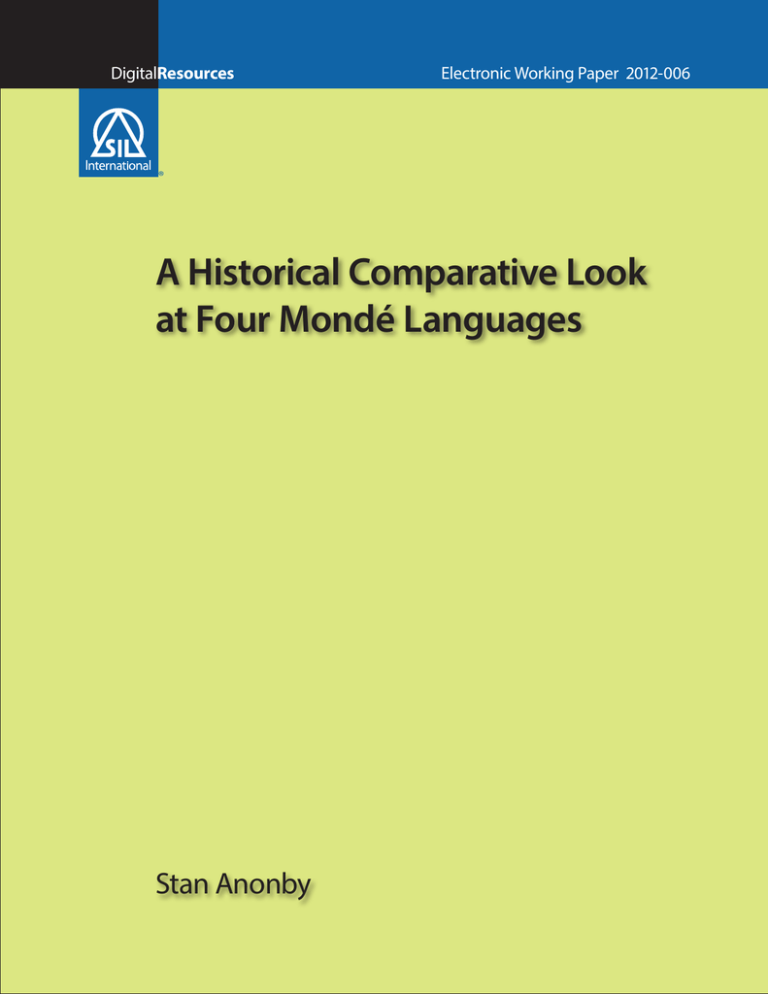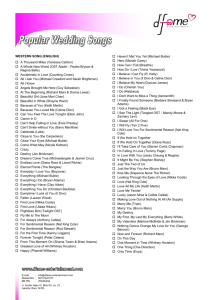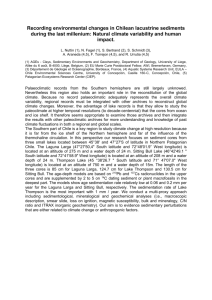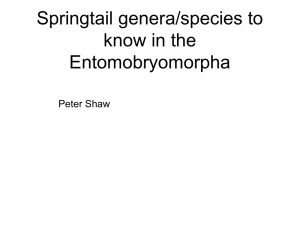A Historical Comparative Look at Four Mondé Languages Stan Anonby Resources
advertisement

DigitalResources
Electronic Working Paper 2012-006
®
A Historical Comparative Look
at Four Mondé Languages
Stan Anonby
A Historical Comparative Look at Four Mondé
Languages
Stan Anonby
SIL International®
2012
SIL Electronic Working Papers 2012-006, October 2012
Copyright © 2012 Stan Anonby and SIL International®
All rights reserved
2
Abstract
The received wisdom is that Gavião, Cinta Larga, and Zoró are very closely related. Most reseachers
consider Zoró and Gavião to be the same language. Surui is seen as a quite divergent member of the
group. However, the comparative method seems to indicate Zoró is most similar to Surui. The most
divergent language appears to be Gavião.
Acknowledgements
I would like to thank Colleen Ahland for teaching me the wonders of the comparative method. She also
helped me edit this paper. I am also grateful to the Surui, Cinta Larga, Gavião, and Zoró who so willingly
recorded all those word lists. Thanks to Norbet Rennert and Panayiotis Pappas for their help in
formatting. Finally, I thank the Summer Institute of Linguistics for funding my trips out into the
hinterlands of Brazil.
Contents
Abstract
Acknowledgements
1. Introduction
2. Methodology
3. Rules for sound changes
3.1. Vowel Raising: o > u
3.2. Spirantization: p > v / __#
3.3 h Deletion with Compensatory Lengthening: Vh>V[long]
3.4 Bilabial Lenition: b>m/#__
3.5 Word Final Vowel Lengthening: V>V[long]/___#
3.6 Glottalization: V>Vʔ/__#
3.7 Rhinoglottophilia: Vh > V[nasal]h
3.8 h Deletion: Vh > V
3.9 Loss of prenasalization: ng > g/#__
3.10 Labial Weakening: v>w/{#}_
3.11 Deaffrication: tʃ>ʃ
4. Summary
References
3
1. Introduction
The Mondé languages of western Brazil are made up of Salamãy, Aruá, Gavião, Cinta Larga, Surui, and
Zoró. Mondé is a small branch of the great Tupi family (Rodrigues 1985, Fabre 2005, Ethnologue 2009).
This paper will look at four of the six languages: Gavião, Cinta Larga, Surui, and Zoró (the other two are
almost extinct).
Local experts, as well as the anthropological and linguistic literature agree that Gavião, Cinta Larga,
and Zoró are very closely related (Furtado 2007, Moore 2005). Most researchers (e.g., Moore 2005, Stute
2007), consider Zoró and Gavião to be the same language. In contrast, Surui is seen as a quite divergent
member of the group. They arrive at the classification based on evidence from mutual intelligibility and
lexical comparisons.
This paper reports on an investigation of the relationship between these four languages, using
data from two word lists: a list of 375 words we1 collected in 2007, and a list of 124 words collected and
phonemicized by Projeto Açai (Sampaio 2000). These data lead us to posit eleven sound changes. They
are attested in only some of the languages, and we base our classification on the patterns of shared
development. The phonological evidence leads us to posit the subgroupings given in Figure 2 (below).
The comparative method seems to indicate Zoró is most similar to Surui. The most divergent language
appears to be Gavião.
I believe the reason Gavião and Zoró were lumped together before probably has much to do with
their rather high degree of mutual intelligibility. Also, when asked, the Zoró and Gavião say they speak
the same language. I propose the similarities are due to contact-induced borrowing, rather than close
genetic relationship.
Maps of Brazil and the area where the Mondé languages are found
1
“We” refers to Dave Eberhard and the author.
4
Figure 1. Family tree proposed by Moore (2005), based on mutual intelligibility,
sound correspondences, and lexical comparisons.
5
This report looks at Surui, Gavião, Cinta Larga, and Zoró from a historical comparative approach.
The study of sound changes would lead us to believe that contrary to popular and academic opinion,
Gavião and Zoró are not very similar genetically. The comparative method also seems to indicate Zoró is
more similar to Surui than was expected (cf. Figure 2). This paper proposes that the similarities between
Zoró and Gavião are due to contact-induced borrowing, rather than close genetic relationship.
Figure 2. New family tree based on historical-comparative evidence.
2. Methodology
I will primarily use the comparative method, described in Campbell (1999:122-167). This method tries
to reconstruct the ancestor language (proto-language) by comparing its daughter languages. It assumes
parts of the proto-language are preserved in the daughter languages.
The first step in the comparative method is to line up similar words (cognate sets) in all four
languages. We assume these descend from a single word in the proto-language. I have two different sets
of words. Some data is taken from Projeto Açai. The words are phonemicized. Other data was recorded
on the survey itself. These words are transcribed phonetically.
The second step is to compare these cognate sets and look at the sounds which are similar (sound
correspondences).
The sounds in Surui, Gavião, Cinta Larga, and Zoró are referred to as reflexes. The comparative
method assumes they descend from a single sound in a proto-language. Campbell outlines guidelines that
historical comparative linguists have developed to help determine how sounds usually change
throughout the years. This leads us to the third step, which is to reconstruct the proto-sound in the
proto-language (Proto-Mondé in this case).
Campbell also talks about how to subgroup languages and make family trees. He claims, “The only
generally accepted criterion for subgrouping is shared innovation” (1999:190). A shared innovation is a
change in some trait of the proto-language which is shared by a subset of daughter languages. It is
assumed that this change did not happen simultaneously in all daughter languages. Rather, it is more
likely the change happened in a single daughter. This one language subsequently split up into various
6
daughter languages. All of these retained this shared innovation. So this innovation is evidence that the
daughters were once a single language, thus they are a subgroup.
In this paper I will explain in detail the eleven sound changes in Surui, Gavião, Cinta Larga, and
Zoró. It will then become clearer why it is possible to interpret the relationship between the Mondé
languages as in Figure 2 above.
3. Rules for sound changes
3.1. Vowel Raising: o > u
Vowel raising is a very common sound change. In this case, it applies to Cinta Larga. The data below
comes from phonetic set B.
Portuguese
English
Surui
Gavião
Cinta Larga
Zoró
maduro
ripe
ijóp
vog
pup
vop
ficar em pé
stand
enóte
adótẽ
endutá
mondótəʔ
longo
long
ʃaktop
ató
tatú
tatóʔ
vir
come
(a)ór
(ʔá) voloʔ
(a)ʔulá
(o)voloʔ
banana
banana
mokobá
bakoá
makuva
mbakoptía
tabaco
tobacco
maʃoʔ
matʃoʔ
maʃu
mãitʃo(kóm)
3.2. Spirantization: p > v / __#
Spirantization (a stop becoming a fricative) is also a very common sound change. In this case, we have
p>v in word final position in Gavião. It is most clearly seen in the phonemicized data set A, used below.
Portuguese
English
Surui
Gavião
Cinta Larga
Zoró
arvore
tree
ihb
ihv
iip
ip
yoykab
ójkàhv
ujkaap
ujkap
patoá
estrela
star
txoy(kab)
gati(kúhv)
juj(kááp)
zuj kap
cerejeira
cherry tree
ihb (kap)kod
a(kàhv)
a(kaáp)
a(kap)
óculos
glasses
la(kaba)
adja(káhv)
paja(kááp)
paja kop sabe
omi(sibeab)
sábéh
sabeeap
mixãgap
korakáv
kurakap
feijão
beans
kurakap
3.3 h Deletion with Compensatory Lengthening: Vh>V[long]
Compensatory lengthening is a very common sound change. When a segment is lost (in this case an h), a
vowel is lengthened to compensate for that loss. This is a regular sound change, found throughout Cinta
Larga. That is, wherever h is lost, the preceding vowel is lengthened.
7
The relative chronology of this rule would have it coming after rule #3.7, shown on the following
page. Historically, the rhinoglottophilia sound change came before Cinta Larga’s h deletion with
compensatory lengthening.
The data below is from the phonemicized set A.
Portuguese
English
patoá
Surui
Gavião
Cinta Larga
Zoró
yoykab
ójkàhv
ujkaap
ujkap
arvore
tree
ihb
ihv
iip
ip
tatu
armadillo
waloy
mazóhj
wanzúúj
wazuj
dente de cutia
agouti tooth
wakĩ ikab
vaki jihj
wakĩĩ jêêj
wakî(jîj)
mutum
curassaw
wajaõ
vakóhj
wakúúj
wakuj
arara
macaw
kasar
kasáhl
kasáál
kasal
3.4 Bilabial Lenition: b>m/#__
In Surui, b weakens to m in word initial position. This is a regular change, occurring throughout Surui. It
would be an ordered sound change, coming after #9. The data is phonemicized.
Portuguese
English
Surui
Gavião
Cinta Larga
Zoró
banana
banana
mokowa
bákóva
mbakubaa
bakuwá
catete
pig
(men)bekod
beekor
(mbe)bekut
(be)bekut
peixe
fish
morib
bolív
mbulíp
bulip
porco
pig
mẽbe kod
bebe(poh)
mbebe kabaa
bebe(pu)
queixada
peccary
mẽbe
bebe
mbebe tere
bebe
espingarda
shotgun
mokaĩab
--
mbáákamán
--
3.5 Word Final Vowel Lengthening: V>V[long]/___#
This sound change applies to Cinta Larga. Cinta Larga vowels are lengthened when they occur at the end
of a word, as seen from the phonemicized data below.
Portuguese
English
Surui
Gavião
Cinta Larga
Zoró
banana
banana
mokowa
bákóva
mbakubaa
bakuwá
coqueiro
coconut palm
pasapwa
pasav
pasabaa
pasawa
lua
moon
ga(ti)kad
gár(ti)
ngat tii
ga(ti)
ventilador
fan
wago
básó dig
mbaasúú
bosu
veado
deer
itiap
iti
itii
iti
rio
river
ih
i
ii
i
8
3.6 Glottalization: V>Vʔ/__#
This sound change applies to Zoró. This is seen more clearly phonetically, in data set B. In phonemic
data set A, ʔ isn’t marked.
Portuguese
English
Surui
Gavião
Cinta Larga
Zoró
morrer
die
ají
avi
pavi
paviʔ
garra, pata
claw, leg
hobaɣ(pi)kũi
(tʃi) pi (kói)
pupa(be)kũi
(tʃi)pi(kõ'iʔ)
mutum
curassaw
wa(kojá)
oa(kói )
va(kui )
wa(kóiʔ)
lavar
wash
pijá
pitʃã'
piʃá
pitʃáʔ
cacique
chief
ləbiwái
dzawidʒai
naveái
dzawijáiʔ
esfregar
rub, scratch
kapkába
kijkija
kipkiva
kipkiwaʔ
3.7 Rhinoglottophilia: Vh > V[nasal]h
Rhinoglottophilia applies sporadically to Cinta Larga, Zoró and Surui, thus providing evidence to group
these three together. In this case of rhinoglottophilia, vowels nasalize when followed by a proto h. This
would have to be an ordered rule, coming before rules #3 and #9. The table contains phonemicized data
from data set A.
Portuguese
English
Surui
Gavião
Cinta Larga
Zoró
espingarda
shotgun
--
togáhv
--
tungãm
fósforo
match
mokaĩ(a)
pókáhj
pukãj ap
pukaj
flauta
flute
wãahp
váv
wa’áp
kuxi(rap)
cará
type of manioc
roah
mojà
mujââ
mujã
terra
land
gõhi
gój
ngûûj
gũj
aranha
spider
gerpã
gérépà
ngerepã
gerepâ
3.8 h Deletion: Vh > V
This applies to Surui, Cinta Larga and Zoró, thus providing evidence to group these three together.
Periodically it even applies to Gavião, as some examples in the preceding table demonstrate. In Gavião, h
deletion appears in only a few cases, indicating the change may be in the initial stages. It is likely the
result of recent contact with the Zoró. This is an ordered sound change, coming after #7. It looks like a
wave change that started with Surui, progressed to Zoró, and is just beginning in Gavião. The data below
is from the phonemicized set A.
Portuguese
English
Surui
Gavião
Cinta Larga
Zoró
castanha
Brazil nut
man(gap)
mav(gáhv)
máam ngap
mam(gap)
estrela
star
txoy(kab)
gati(kúhv)
juj(kááp)
zuj kap
9
cerejeira
cherry tree
ihb (kap)kod
a(kàhv)
a(kaáp)
a(kap)
lagoa
lagoon
ikara
íkàhr
ikáát
ikat
fósforo
match
mokaĩ(a)
pókáhj
pukãj ap
pukaj
foto
photo
ixo
pàhxo
pááxú
paxu
3.9 Loss of prenasalization: ng > g/#__
Prenasalized consonants lose prenasalization in Surui and Zoró. The Gavião later lost prenasalization
under the influence of Zoró. After the Surui attacked them in the 1970’s, all the Zoró moved into the
Gavião village for a time. The two groups intermarried, and continue interacting until today. I surmise
that it was this contact that caused the Gavião to lose prenasalization. This loss of prenasalization comes
before sound change #4. It is most clearly seen in the phonemicized data set A, used in the examples.
Portuguese
English
Surui
Gavião
Cinta Larga
Zoró
floresta
forest
gara
gàla
ngala
gala
lua
moon
ga(ti)kad
gár(ti)
ngat tii
ga(ti)
castanha
Brazil nut
man(gap)
mav(gáhv)
máam ngap
mam(gap)
sol
sun
gad
gár
ngát
gat
terra
land
gõhi
gój
ngûûj
gũj
aranha
spider
gerpã
gérépà
ngerepã
gerepâ
3.10 Labial Weakening: v>w/{#}_
In Surui, Cinta Larga, and Zoró, v weakens to w word initially. This change groups Surui, Cinta Larga,
and Zoró together. This phenomenon occurs quite frequently, and is also known as lenition. It is
particularly common for a consonant to weaken to a glide. I have posited this change because weakening
to a glide is common, and because Surui, Cinta Larga, and Zoró share other innovations.
The data below is phonemic.
Portuguese
English
Surui
Gavião
Cinta Larga
Zoró
jenipapo
type of bush
wexoa
vesóa
wesúa
wesua
anta
tapir
wasa
vása
wása
wasa
jacaré
alligator
wao
vavó
wawú
wawu
cutia
agouti
wakĩ
váki
wakĩĩ
wa’kĩ
mutum
curassaw
wajaõ
vakóhj
wakúúj
wakuj
papagaio
parrot
awara
aválav
awáálap
awalap
10
3.11 Deaffrication: tʃ>ʃ
Deaffircation applies to Surui, Cinta Larga, and Zoró, and supports subgrouping them together. The Zoró
lived with the Gavião, on the Gavião reserve for many years and they continue to live in close proximity.
The Zoró most likely reverted back the tʃ under the influence of the more numerous and prestigious
Gavião. (It may be in the realm of an areal feature). The Zoró would have borrowed affrication from the
Gavião. As a result, this change would not be expected to follow regular sound correspondences. It is
seen most clearly in the more phonetic data set B.
Portuguese
English
Surui
Gavião
Cinta Larga
Zoró
noite
night
miʃãŋ
bitʃaŋ(i)
miʃa
bitʃəŋ
pedra
rock
iʃá
itʃía
iʃá
itʃá
tabaco
tobacco
maʃoʔ
matʃoʔ
maʃu(kũ')
mãitʃo(kóm)
pequeno
small
iʃín
tʃitʃit
kipʃĩ
tʃitʃín
pedregulho
pebble
iʃəkəlá
itʃəkʌ'p
iʃákiɾá
itʃaɣə'p~itʃasaiɾía
molhar
wet
ʃija(muŋap)
tʃiʔá
ʃimá
tʃimã'ʔ
4. Summary
So, how do the rules outlined above support my position that Zoró is not closely related genetically to
Gavião, but rather to Surui? First, Cinta Larga, Surui, and Zoró share the same four sound changes:
(7)rhinoglottophilia, (8)h-deletion, (10)labial weakening and (11)deaffrication, which group them
together. Then, Surui and Zoró share the (9)loss of prenasalization, setting them both apart from Cinta
Larga. These shared innovations are evidence of genetic relationship. I found no shared innovations
between Gavião and Surui, indicating they are more distantly related.
11
References
Campbell, Lyle. 1999. Historical linguistics. Cambridge, Mass.: MIT Press.
Dal Pos, João. 2009. Localização e população. Encyclopedia of Indigenous Peoples. Institute.
Fabre, Alain 2005. Diccionario etnolingüístico y guía bibliográfica de los pueblos indígenas sudamericanos.
https://butler.cc.tut.fi/~fabre/BookInternetVersio/Dic=Tupi.pdf, (accessed September 20, 2012).
Furtado, Adilton. April 15, 2007. Personal communication.
Lewis, M. Paul, ed. 2009. Ethnologue: Languages of the world. Sixteenth edition. Dallas: SIL International.
Online version: http://www.ethnologue.com/.
Moore, Denny. 2005. Classificação interna da família lingüística Mondé. Estudos Lingüísticos 34:515–
520.
Petrucci, Victor A. 2000. Tupi Guarani. Indigenous Languages - Línguas Indígenas.
http://www.geocities.com/indianlanguages_2000/tupi.htm (accessed March 7, 2007 but appears to
be offline now).
Rodrigues, Aryon Dall’Igna. 1985. Relações internas na família lingüística Tupí-Guaraní. Revista de
Antropologia 27/28:33–53.
Sampaio, Wany. 2000. Projeto Açai – curso de formação de professors índios. Disciplina – Lingua
Indígena: estudo de vocabulario. (March 29, 2000)
Socioambiental. http://pib.socioambiental.org/pt/povo/zoro/2064 (accessed June 8, 2012).
Stute, Horst. April 15, 2007. Personal communication.




